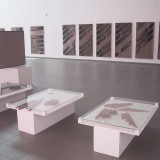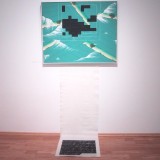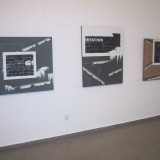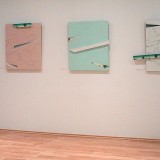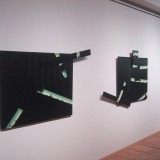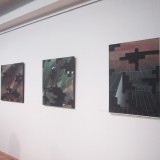Grzegorz Sztabiński
Grzegorz Sztabiński is a university professor and he has worked at the University of Łódź since 1974. He focuses on art history and aesthetics and he specialises in contemporary art issues. However, apart from university education, he also was educated as an artist. He studied at the Łódź Art College (now the Academy of Fine Arts), where he also lectured, not only upon the history of art, as he also ran the Studio for the Basics of Composition. These two trends of his work – art theory and artistic practice have intermingled and complemented each other throughout his entire professional career.
The review exhibition of Sztabiński’s art, which took place at the turn of 2006 to 2007 in the City Art Gallery in Łódź (so called Art Propaganda Centre) was entitled Retrospection. The title may at first bring associations with a “retrospective”, therefore a presentation showing completed art activity, which for some reason the gallery had decided to remind the public of. However in this case it would be more proper to associate it with the word “introspection”. Sztabiński’s art has not at all been finished, neither on the field of theory nor the visual arts. Despite many years of work, his scholarly research and visual artworks still emerge, bringing new results. The exhibition entitled Retrospection created an opportunity for insight (introspection) into many years of his work. Sztabiński has worked creating series of works which he sometimes continued for many years. This working method allows him to trace the changes in his art and thinking through theory, but because the author is well oriented in the most recent academic research about art and trends in art development, it also allows him to trace the changes in the art world. Insight (introspection) into Sztabiński’s art shows his scholarly and visual thinking as a coherent whole. This comprehensive approach to art, situated in a historical perspective is what characterises his intellectual, scholarly stance and his academic and artistic achievements. The theory and art appear as one. It is not a common stance. Usually an academic who researches art is perceived as being in opposition to an artist who creates it. It is a stereotype rooted in the so called “art world”, a false opposition.
Let’s remember that a similar conflict in art took place in the end of the sixties and the beginning of seventies, when conceptual art pointed at its main artistic opponent as being abstract expressionist painting, which was then a dominating – seemingly absolutely – tendency on the art scene. However conceptual art then offered a new way of defining art as making meanings not artefacts, which turned out to be so attractive for artists that it dominated the art scene for the next decade. Theory became art, the artist became a researcher. The results of the “conceptual turn” till now shape the contemporary tendencies of art development, which put forth the task of looking for new ways of participating in cultural discourse at the forefront of art. Sztabiński’s work starts exactly at the threshold of the conceptual era and its principles shaped his thinking, including the assumption of the tight relationship between art theory and practice.
The topic of his art is the semiotics of art, treating it as a language. The semantics of signs by using which “one speaks” in this language refers to art. But it’s not about a modernist “art for art’s sake”, but about researching the possibilities of constructing and the expression of content. It is illustrated by the series of Sztabiński’s works, such as Logical landscapes, Objects, Symbolisations, Auto-quotations, Cuts, Inter-things. Artistically and formally they reach a constructivist tradition – a geometric abstraction. The pattern of the art of this provenance, which is still influential in the Łódź milieu, is the heritage of Strzemiński who made theory a basis for artistic work within painting and the discussion about culture and society. Sztabiński considers theoretical grounds of artistic ways of seeing in his art. But his contemporary works belong to a trend which may be collectively named post-conceptual. The evolution which took place between the conceptualism of the seventies and its late version of the eighties was caught in Sztabiński’s series entitled The eighties. Created in 1990, it is a summary of the decade of the eighties. The work includes a historical reflection but at the same time is a personal analysis by the author of his own path within art. In a Carthesian way one could treat this summary with doubt. Here in the modernist formalist paradigm of art for art’s sake, which finally leads the artist to find confirmation of the meaning of form, as only after stating its pluralism and usefulness in the plays on meanings, its new place in a contemporary post-conceptual art discourse is pointed out. According to Sztabiński’s method it became established in the theoretical reflection.
Sztabiński’s last book Different avant-gardes ideas shows the evolution of idea from the sources of modernity to after-modern contemporary times. An important discovery, which had the power of explaining the essence of the evolution of art, points towards the fact that in the theory there occurred a shift between dominating avant-garde ideas. So it is not a “discovery” of new ideas, but pointing at the fact that contemporary times use other ideas from the theoretical spectrum of avant-gardes than those which had taken place in the beginning of the history of the avant-garde in art. His ideas such as community, freedom and authority are still actual narrations of art and culture. Sztabiński’s book proves that the first reaction of choking with postmodernism, as we revoked the avant-gardes together with the modernist art for art’s sake was too fast. With this, he finally proves the continuity and unity of art, which as been a theme of his work since the seventies. Conceptual and post-conceptual art finally turn out to be adjusted of art to its role in culture. Conceptual art – so important for the world of art, is also very strong in Łódź community. One can see its tradition in both the constructivist avant-garde trend and the variety of trends since the seventies, sometimes competing with each other. But today these differences turn out to be minor. The essence is the continuity of the ideas of the avant-gardes which lasts in the post-conceptual art of the Łódź milieu. It is not then an accident, that both the history and contemporary times of the avant-garde were worked out in Łódź.
Łukasz Guzek


